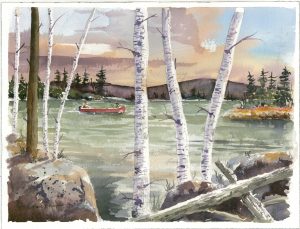Streamers for Spring Salmon

By Benjamin Rioux – Ilustration by V. Paul Reynolds
Open water fishing has finally arrived in northern Maine, though any actual open water has been difficult to come by. Swinging streamers during the month of April comes with its own set of challenges, and the risk encountered while fishing these frigid waters will quickly outweigh the rewards if proper precautions aren’t taken. Still, spring fishing on the Fish River has produced more fish, and more memories on the water than I could ever write about in a year of monthly columns. Something about navigating a rushing current in the spring fog can leave you feeling peaceful, even on turbulent waters. For me, streamer fishing is the absolute essence of classic fly fishing, right down to its very core. I live for giant, hook-jawed landlocked salmon, and no time of the year has produced more photo-worthy fish for me than April and May.
I learned to fly fish on the banks of the Fish River when I was a teenager, and although life has taken me far away from those banks at times, I’ll always consider the lower Fish my home. Over the years I’ve spent more time trolling, casting, and working currents in that few miles of river than I have anywhere else in the state. Consequently, I’ve learned a thing or two about finding success on early season days where most anglers have yet to reach for a fly rod. There really are no secrets in fly fishing; at least none that outrank timing and luck. No secret flies, thousand dollar fly rods, or time-tested techniques will bring you success if you aren’t putting your time in on the water. Want to know how to catch more fishing? Who cares if its raining, or snowing, or windy. Put your time in on the water, and I guarantee you that not a second will be wasted.
When choosing streamers, I’ve always chosen patterns tied on long shank (8x or 6x) hooks as opposed to the tandem rigs that seem to be all the rage in local fly shops. In my experience, tandem rigs simply don’t put up with the same abuse that their single hooked, long shanked patterns do. My spring box is full of patterns I’ve acquired over the years, but a vast majority of those patterns are variations of the classic Carrie Steven’s Gray Ghost. Favorites include red, green, or yellow variations, but the classic pattern to this day has produced more fish for me in the widest range of conditions. Additional classics I’ve put to good use include the Joe Smelt, Mickey Finn, and another favorite, the Dr. Burke. Smelt patterns are a must in early Spring on the Fish River, and I tend to fish nothing but smelt variations until late May or even early June. In my experience, they just seem to produce larger fish more constantly.
As far as methods are concerned, an average night on the river for me includes a modest mix of trolling and casting as I make my way from the lower rips, around corners, and finally to the base of the Fish River Falls. More often then not, I find most success fishing the deep corner pools that form around swift inside currents. Anchoring at the top of these corners allows me to swing streamers in and out of the currents as I strip and retrieve my line at slow, consistent intervals. During early spring I use a heavy sink-tip line and anywhere between nine to eleven feet of Maxima chameleon leader material. I like long heavy (8lb-10lb) leaders earlier in the season because they get my streamers further from the fly line, typically improving my success with what always seem to be more lethargic, picky fish. As the waters drop and warm, and salmon become more active, I swap my sink-tip line for a floater, and follow suit with my leaders. Still, I favor large, meaty single hook streamers at these levels as well.
My retrieval tends to speed up in warmer conditions, but my method remains otherwise unchanged. In late May and early June, I throw wet flies and even Wulffs into the mix on days when trolling isn’t producing and fish begin looking for flies closer to the surface. By late May I find the majority of my success at or around the Fish River Falls, and depending on water levels, spend a fair amount of time exploring stretches north of the falls in my waders closer to Soldier Pond.
Regardless of the methods employed, the Fish River and it’s chain of lakes provides an absolutely breathtaking backdrop for your spring fishing outing. Be sure to keep a keen eye on water levels, ice, and other floating debris, and always wear a lifejacket. Practice catch and release when possible, and be sure to check your rule book for proper length and bag limits. As always, fish with a partner, and be sure to wave if we meet on the river! The spring rush is on, and there is plenty of action in northern Maine for everyone.
Ben is an avid fly fisherman and the owner of maineflycastings.com, an independent fly fishing blog based out of Fort Kent, Maine. He spends his days tying flies, wading rivers, and editing the photographs that he captures along the way. Ben can be reached at [email protected].
For more articles and stories about hunting, fishing and the outdoors, be sure to subscribe to our monthly publication the Northwoods Sporting Journal.
To access past copies of the Northwoods Sporting Journal in digital format at no charge, click here.
